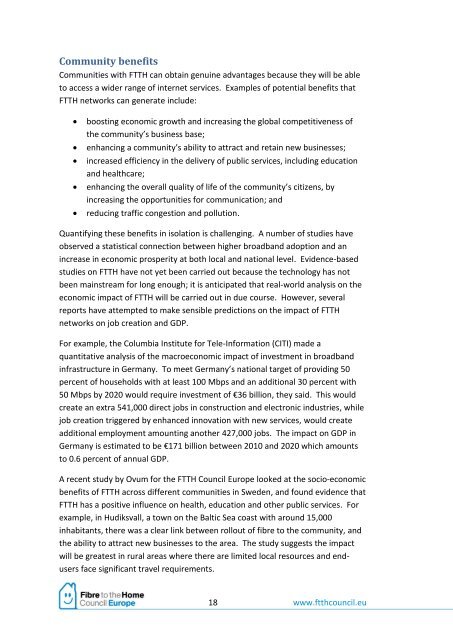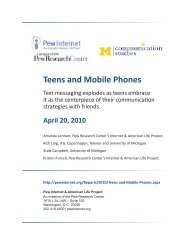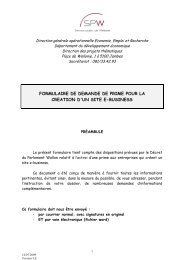Create successful ePaper yourself
Turn your PDF publications into a flip-book with our unique Google optimized e-Paper software.
Community <strong>be</strong>nefits<br />
Communities with <strong>FTTH</strong> can obtain genuine advantages <strong>be</strong>cause they will <strong>be</strong> able<br />
to access a wider range of internet services. Examples of potential <strong>be</strong>nefits that<br />
<strong>FTTH</strong> networks can generate include:<br />
� boosting economic growth and increasing the global competitiveness of<br />
the community’s business base;<br />
� enhancing a community’s ability to attract and retain new businesses;<br />
� increased efficiency in the delivery of public services, including education<br />
and healthcare;<br />
� enhancing the overall quality of life of the community’s citizens, by<br />
increasing the opportunities for communication; and<br />
� reducing traffic congestion and pollution.<br />
Quantifying these <strong>be</strong>nefits in isolation is challenging. A num<strong>be</strong>r of studies have<br />
observed a statistical connection <strong>be</strong>tween higher broadband adoption and an<br />
increase in economic prosperity at both local and national level. Evidence-based<br />
studies on <strong>FTTH</strong> have not yet <strong>be</strong>en carried out <strong>be</strong>cause the technology has not<br />
<strong>be</strong>en mainstream for long enough; it is anticipated that real-world analysis on the<br />
economic impact of <strong>FTTH</strong> will <strong>be</strong> carried out in due course. However, several<br />
reports have attempted to make sensible predictions on the impact of <strong>FTTH</strong><br />
networks on job creation and GDP.<br />
For example, the Columbia Institute for Tele-Information (CITI) made a<br />
quantitative analysis of the macroeconomic impact of investment in broadband<br />
infrastructure in Germany. To meet Germany’s national target of providing 50<br />
percent of households with at least 100 Mbps and an additional 30 percent with<br />
50 Mbps by 2020 would require investment of €36 billion, they said. This would<br />
create an extra 541,000 direct jobs in construction and electronic industries, while<br />
job creation triggered by enhanced innovation with new services, would create<br />
additional employment amounting another 427,000 jobs. The impact on GDP in<br />
Germany is estimated to <strong>be</strong> €171 billion <strong>be</strong>tween 2010 and 2020 which amounts<br />
to 0.6 percent of annual GDP.<br />
A recent study by Ovum for the <strong>FTTH</strong> Council Europe looked at the socio-economic<br />
<strong>be</strong>nefits of <strong>FTTH</strong> across different communities in Sweden, and found evidence that<br />
<strong>FTTH</strong> has a positive influence on health, education and other public services. For<br />
example, in Hudiksvall, a town on the Baltic Sea coast with around 15,000<br />
inhabitants, there was a clear link <strong>be</strong>tween rollout of fibre to the community, and<br />
the ability to attract new businesses to the area. The study suggests the impact<br />
will <strong>be</strong> greatest in rural areas where there are limited local resources and endusers<br />
face significant travel requirements.<br />
18 www.ftthcouncil.eu

















